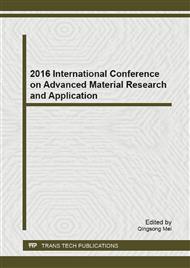[1]
Carlo I., Agata L. G., Jacopo B., Caterina T., Giovanni D., Marco F., Valentina S., Charles M. Energy and environmental assessment of industrial hemp for building applications: A review. Renew. Sust. Energ. Rev. 51 (2015) 2942.
Google Scholar
[2]
M.A. Dweib, C.F. Vahlund, C.M. OBradaigh. Fiber structure and anisotropy of glass reinforced thermoplastics. Composites: Part A. 31 (2000) 235244.
DOI: 10.1016/s1359-835x(99)00078-0
Google Scholar
[3]
A. Trende, B.T. Astrom, G. Nilsson. Modelling of residual stresses in compression moulded glass-mat reinforced thermoplastics. Composites: Part A . 31 (2000) 12411254.
DOI: 10.1016/s1359-835x(00)00078-6
Google Scholar
[4]
S.H. Jo, E.G. Kim. Effect of product geometry on fiber orientation of compression-molded rib type products. J. Mater. Process. Technol. 130131 (2000) 156160.
Google Scholar
[5]
H. Ning, S. Pillay, U. K. Vaidya. Design and development of thermoplastic composite roof door for mass transit bus. Mater. Des. 30 (2009) 983991.
DOI: 10.1016/j.matdes.2008.06.066
Google Scholar
[6]
A. Gay, F. Lefebvre, S. Bergamo, F. Valiorgue, P. Chalandon, P. Michel. P. Bertrand. Fatigue performance of a self-piercing rivet joint between aluminum and glass fiber reinforced thermoplastic composite. Int. J. Fatigue. 83 (2016) 127-134.
DOI: 10.1016/j.ijfatigue.2015.10.004
Google Scholar
[7]
H. Rolland, N. Saintier, N. Lenoir, A. King, G. Robert. Fatigue mechanisms description in short glass fiber reinforced thermoplastic by microtomographic observations. Procedia Structural Integrity. 2 (2016) 301-308.
DOI: 10.1016/j.prostr.2016.06.039
Google Scholar
[8]
N. A. Shuaib, P. T. Mativenga. Energy demand in mechanical recycling of glass fibre reinforced thermoset plastic composites. J. CLEAN. PROD. 120 (2016) 198-206.
DOI: 10.1016/j.jclepro.2016.01.070
Google Scholar
[9]
Z. Huang, S. Sugiyama, J. Yanagimoto. Applicability of adhesiveembossing hybrid joining process to glass-fiber-reinforced plastic and metallic thin sheets. J. Mater. Process. Technol. 214 (2014) 2018-(2028).
DOI: 10.1016/j.jmatprotec.2013.11.020
Google Scholar
[10]
Z. Huang, S. Sugiyama, J. Yanagimoto. Adhesiveembossing hybrid joining process to fiber reinforced thermosetting plastic and metallic thin sheets. Procedia Engineering. 81 (2014) 2123-2128.
DOI: 10.1016/j.proeng.2014.10.296
Google Scholar
[11]
Sofie Baeten, Ignaas Verpoest. Optimisation of a GMT-based cold pressing technique for low cost textile reinforced thermoplastic composites. Composites: Part A. 30 (1999) 667682.
DOI: 10.1016/s1359-835x(98)00173-0
Google Scholar
[12]
M.D. Wakeman, T.A. Cain, C.D. Rudd, R. Brooks, A.C. Long. Compression moulding of glass and polypropylene composites for optimised macro- and micro-mechanical properties II. Glass mat reinforced thermoplastics. Compos. Sci. Technol. 59 (1999).
DOI: 10.1016/s0266-3538(98)00124-9
Google Scholar
[13]
S.F. Bush, F.G. Torres, J.M. Methven. Rheological characterisation of discrete long glass fiber (LGF) reinforced thermoplastics. Composites: Part A. 31 (2000) 14211431.
DOI: 10.1016/s1359-835x(00)00089-0
Google Scholar


